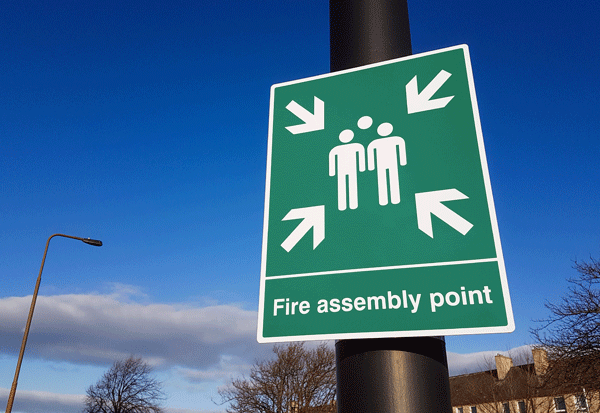The Role of the Fire Assembly Point
A fire assembly point is a designated place of safety where people have been told to wait after evacuating a building in the event of a fire or other emergency.Using a fire assembly point will help to ensure:
- The safety of evacuated persons
- That a roll call can be taken to ensure that all persons are accounted for
- That easy access to the premises is maintained for fire brigade appliances
- That a point of contact is maintained between fire brigade and the fire safety manager should information be required for search and rescue of trapped or missing persons or for firefighting operations
- That information in respect of the current situation can be relayed to all those affected
- That family members or groups can be reunited
- That any injured persons can receive first aid
The key requirement then in selecting a suitable place of safety for a fire assembly point is that there should be no danger to the assembled persons from the fire. The following factors should be considered:
- It should be sited clear of the risk of radiant heat, smoke, toxic gases, falling masonry/debris, and any explosive risk
- It should be sited so that people ideally do not have to mix with site traffic or cross public roads on route to it
- It should ideally not be sited in a noisy location that may make it difficult for any person conducting a roll call to hear responses
- It should not obstruct emergency service vehicles or hinder firefighting operations
- It should ideally be within the perimeter of the grounds
- It should be far enough away from the building to afford protection from the fire but not so far away as to discourage people, particularly people with mobility impairments, from using it
- It should be visible and easily identifiable by appropriate signage and lighting

Not all buildings will have private grounds where a suitable fire assembly point can be sited, e.g. retail outlets and offices in town centres. When siting an assembly point in a public space, you should choose a space that can safely accommodate the number of people likely to use it. The evacuated persons may need to form an orderly line and be supervised, so clear instruction and regular fire drills will be particularly important. It is not necessary (and usually not possible) to use an assembly point sign in a public space so a clear description and a diagram of the location will be essential. For a small premises such as a shop on a street, for example, the assembly point may be on the public footpath outside of a neighbouring shop at least four or five shops away.
On their way to the assembly point, all evacuating persons should behave as follows:
- They should remain calm and not panic or run
- They should not stop to collect personal belongings
- They should close all fire doors behind them and close windows if possible
- They should assist in evacuating others who may need help, but without taking personal risks
- They should abandon equipment in a safe condition where applicable, e.g. turn-off cooking equipment, power tools, portable heaters, machinery, etc
- They should remain calm and stay together as an ordered and disciplined group
- They should not hinder emergency service vehicles or firefighting operations
- They should not re-enter the building until authorised by the fire safety manager (in the event of a false alarm) or by the officer-in-charge of the fire brigade (in the event of their attendance)
- They should not engage in loud conversation that may make it difficult for the person conducting the roll call to hear responses
- The provision of seating for elderly/infirm/disabled persons
- The provision of survival blankets and rain ponchos during inclement weather
- The provision of a first aid kit and trained first aider
- Calling an ambulance if required
- Informing the fire brigade immediately on their arrival of any trapped or missing persons
- Not using the fire assembly point if you have received a bomb threat or other terrorist threat
Antrim, Armagh, Carlow, Cavan, Clare, Cork, Derry, Donegal, Down, Dublin, Fermanagh, Galway, Kerry, Kildare, Kilkenny, Laois, Leitrim, Limerick, Longford, Louth, Mayo, Meath, Monaghan, Offaly, Roscommon, Sligo, Tipperary, Tyrone, Waterford, Westmeath, Wexford, and Wicklow



